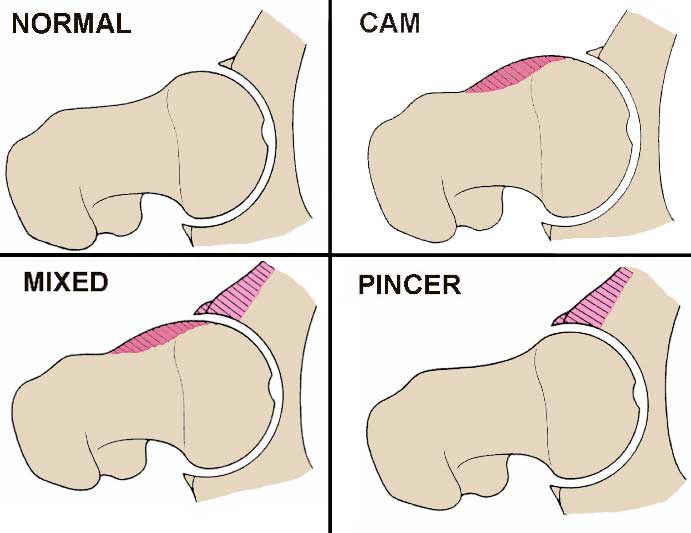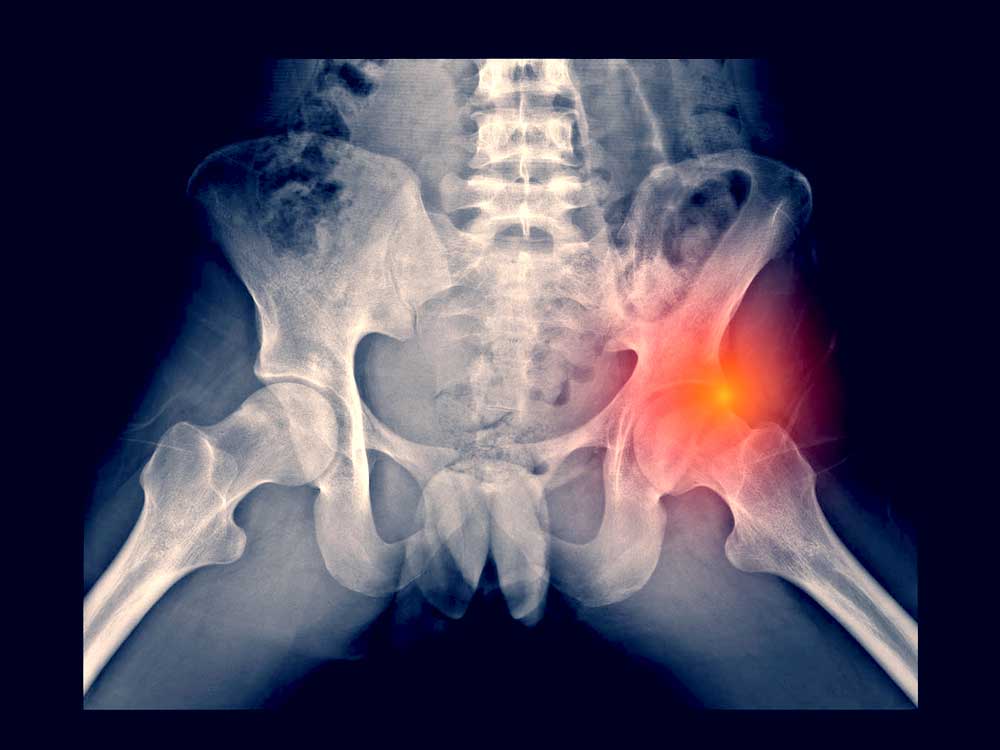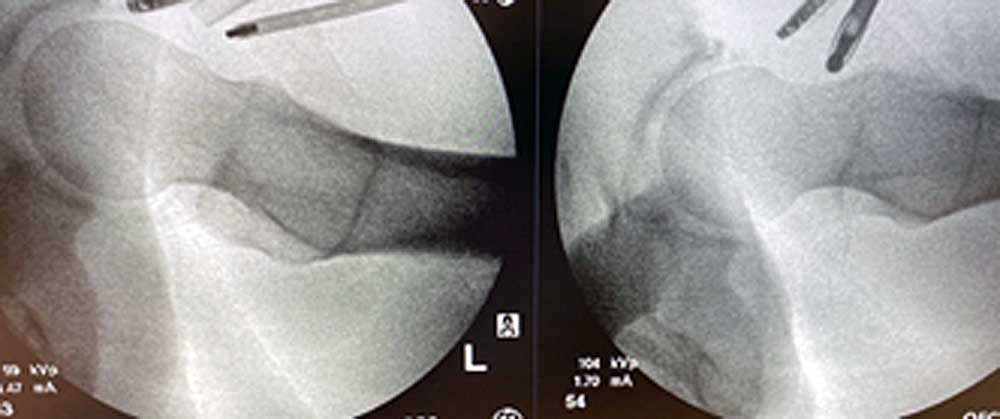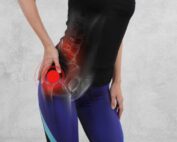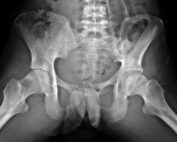Dr. Benedict Nwachukwu, Femoroacetabular Impingement (FAI Hip) Specialist in NYC, Answers

Q: What is FAI, and how do I know if I have it?
Femoroacetabular impingement (FAI) occurs when abnormally-shaped bones in the hip joint move rigidly against each other causing hip pain and a breakdown of cartilage. Young, active adults are most commonly affected and left untreated, FAI can lead to extensive cartilage damage or labral tears.
Common signs include:
- Sharp ongoing pain in groin area
- Hip pain ranging from a dull ache to stabbing and intense
- Stiffness and decreased range of motion
- Clicking or locking in hip
If these symptoms sound familiar, an evaluation is recommended. In many cases, non-surgical options are effective, although I often see patients after they’ve tried PT without relief. Diagnosis usually includes a detailed physical exam, X-rays, and MRI.
“Most of my patients with FAI don’t realize how much better they can feel until we address it. Early treatment prevents long-term joint damage.”
— Dr. Nwachukwu, Board-Certified, Fellowship-Trained Orthopedic Surgeon
What causes FAI hip impingement (femoroacetabular impingement)?
The hip joint in the pelvis is a ball-and-socket joint formed by the head of the femur at the top of the thigh fitting into the acetabulum, a socket covered in a slippery tissue called articular cartilage. (See hip anatomy image.) This cartilage helps protect the joint and allows the joint to move smoothly with very little friction. In patients who have hip impingement, this cartilage is worn away quicker than in normal hips because misaligned, abnormally-shaped bones move rigidly against each other causing a breakdown of cartilage. Femoroacetabular impingement (FAI) is caused when bony overgrowths in the hip joint rub against the acetabulum preventing smooth motion of the joint.
Can hip impingement cause a labral tear?
FAI hip impingement can also lead to tearing of the labrum, a collagenous structure that surrounds the socket of the hip. The labrum is important to protect the articular cartilage and to provide stability to the hip joint. Femoroacetabular hip impingement may begin in childhood and is a major contributing factor of early degenerative joint disease of the hip in young, active patients.
Are there different kinds of hip femoroacetabular impingement (FAI hip impingement)?
There are several distinct types of femoroacetabular impingement in the hip. Patients may be diagnosed with one specific type, or a combination of these conditions:
- Cam Impingement (Pistol Grip Impingement): This type of hip impingement is caused by an irregularly shaped femoral head and neck junction. When the ball of the femur is not round and smooth, it cannot rotate correctly inside the socket (acetabulum). (Cam deformities of the hip are often referred to as placing a square peg in a round hole.) This anatomic abnormality causes excessive grinding against the cartilage inside the joint and can also tear the labrum.
- Pincer Impingement: This type of hip impingement occurs when the front rim of the hip socket (called the acetabulum) sticks out too far and is more common in females. The neck of the femur (thigh bone) bumps into the protruding rim of the socket during normal hip flexion. This may cause damage to the articular cartilage and may crush the labrum.
- Cam and Pincer Impingement (Combined Impingement): The most common form of hip impingement is combined impingement where both pincer and cam impingements are present.
How common is FAI hip impingement?
While hip FAI is somewhat common, it is unknown how many people have it. Some individuals have hip femoroacetabular impingement and will never know as long as they remain asymptomatic. In most cases, when pain, stiffness, and other symptoms appear, it is because damage to the articular cartilage or labrum has begun. This can be a red-flag signaling that degeneration may continue to progress without proper treatment.
What are FAI hip symptoms?
Patients in New York typically report the following symptoms of hip femoroacetabular impingement:
- Sharp, ongoing pain in the groin area, especially when the hip is flexed and internally rotated (turned inward).
- Pain that radiates to the outside of the hip.
- Pain in the hip that can vary from a dull ache to stabbing and intense.
- A limp when starting to walk.
- Stiffness and decreased range of motion in the hip
How is hip FAI diagnosed?
Dr. Nwachukwu will examine the hip to determine if femoroacetabular impingement is the cause of a patient’s symptoms. He will conduct a detailed physical exam, consisting of multiple tests. One specific maneuver is called an impingement test, where he moves the knee closer to the chest and then rotates it in towards the shoulder. If this causes groin pain, FAI may be the diagnosis. In almost all cases, Dr. Nwachukwu will also use imaging to evaluate the joint. X-rays provide the opportunity to look at the bone itself and determine if they are misshapen. In many cases, Dr. Nwachukwu will also utilize an MRI (magnetic resonance imaging) scan to examine the soft tissues and cartilage within the hip to evaluate the hip labrum, cartilage and other soft tissue structures around the hip.
What is hip FAI treatment?
Non-surgical FAI Treatment
Treatment for femoroacetabular impingement in the hip will depend on the severity of symptoms. Some patients will be able to be treated conservatively with:
- Change of activity and physical therapy – if certain activities such as sports or lifting are causing the pain, Dr. Nwachukwu may recommend avoiding these activities for a short period of time.
- Non-steroidal anti-inflammatory drugs (NSAIDs) – may be of benefit along with activity modification.
- Hip joint injection – for some patients, hip injections can be useful for providing pain relief and can provide sustained long-term relief. If long-term relief is obtained, injections can be safely administered periodically. Effective pain relief from a hip joint injection can also be a valuable diagnostic tool for identifying the hip joint as the primary source of pain.
Patients should expect to have a detailed conversation with Dr. Nwachukwu about non-operative treatment options.
Strengthening Exercises to avoid surgery for hip impingement (FAI)
Dr. Nwachukwu has a series of hip mobility and strengthening exercises to help patients avoid surgery for femoroacetabular impingement. This series of videos can be found here: Hip Exercise Videos.
FAI Surgery
Dr. Nwachukwu will only recommend FAI surgery after an adequate trial of non-operative hip FAI treatments. In patients requiring femoroacetabular impingement surgery, an arthroscopic repair called osteochrondroplasty is performed. This minimally invasive procedure uses a small camera (arthroscope) and special tools inserted through two to three holes approximately 1cm each.
- Femoroplasty – corrects cam impingement by shaving down the bumps on the femoral head or neck (ball) when bone spurs have caused friction damaging the articular cartilage and, in some cases, labrum.
- Acetabuloplasty – corrects pincer impingement by trimming the bony rim of the acetabulum socket when bony overgrowth has caused pinching of the labral cartilage.
- Osteochondroplasty – corrects both cam and pincer impingements (combined impingement) by reshaping the femoral head and neck (ball) as well as the acetabulum (socket).
Hip surgeries for FAI generally help reduce the symptoms caused by the impingement as well as helping to slow down or prevent future damage to the hip joint. It is important to note that patients with FAI are potentially at risk for future joint damage. This underscores the importance of seeking treatment as soon as symptoms appear from a qualified orthopedic hip specialist to yield better long-term results.
Hip problems can be difficult to diagnose and treat, therefore, it is important to seek treatment from Dr. Nwachukwu who has specific training and expertise in hip arthroscopy and FAI hip impingement
What is the recovery like after FAI hip surgery?
It is absolutely essential that patients follow the protocol for post-op recovery as set forth by Dr. Nwachukwu. He will provide a well-supervised physical therapy program following arthroscopic hip surgery for FAI so that a normal range of motion and mobility can be achieved. Each patient will begin a program with highly skilled therapists immediately following surgery to expedite rehabilitation and recovery times. (Traveling patients are provided with the same protocol so therapy can continue locally once they return home.)
Patient Testimonial for Hip Impingement Treatment

“From the very first appointment with Dr. Nwachukwu to the 2nd post-op check-up, I truly felt taken care of. Through every step of the process I was told what to expect and was well prepared. I think this was due in large part to the level of detail Dr. Nwachukwu and his team demonstrated. I had an invasive surgery which required removal of a decent amount of calcification from my left rectus femoris. It was supposed to take roughly 3-6 months for full recovery. However, I was able to make a full recovery in 5 weeks. I credit my recovery wholly to Dr. Nwachukwu and Dr. Gausden.”
– Jonathan Onyiriuka, Brooklyn, NY
HSS Providers: Dr. Benedict Nwachukwu, MD, MBA; Dr. Elizabeth B. Gausden, MD, MPH
FAQ: Hip FAI, Hip Impingement, Stiff Hips
Latest FAI Research
Content reviewed by Dr. Benedict Nwachukwu, Board Certified Orthopedic Surgeon, Hospital for Special Surgery. For more information on femoroacetabular impingement (FAI) or for additional resources on hip pain and general hip impingement, please contact the office of Benedict Nwachukwu, MD, orthopedic hip specialist serving Manhattan, New York City and surrounding New York boroughs.

